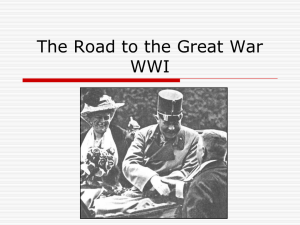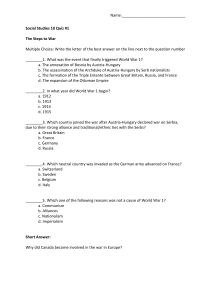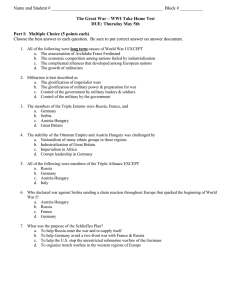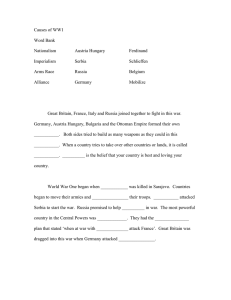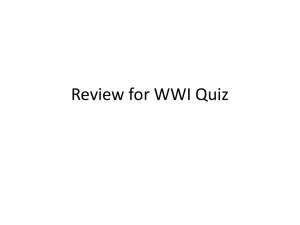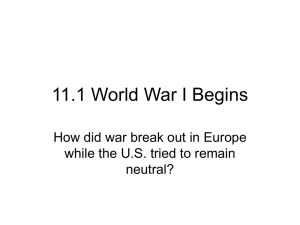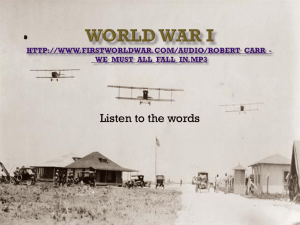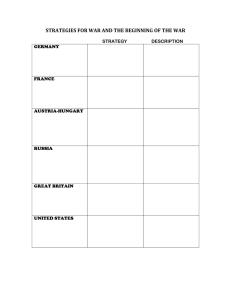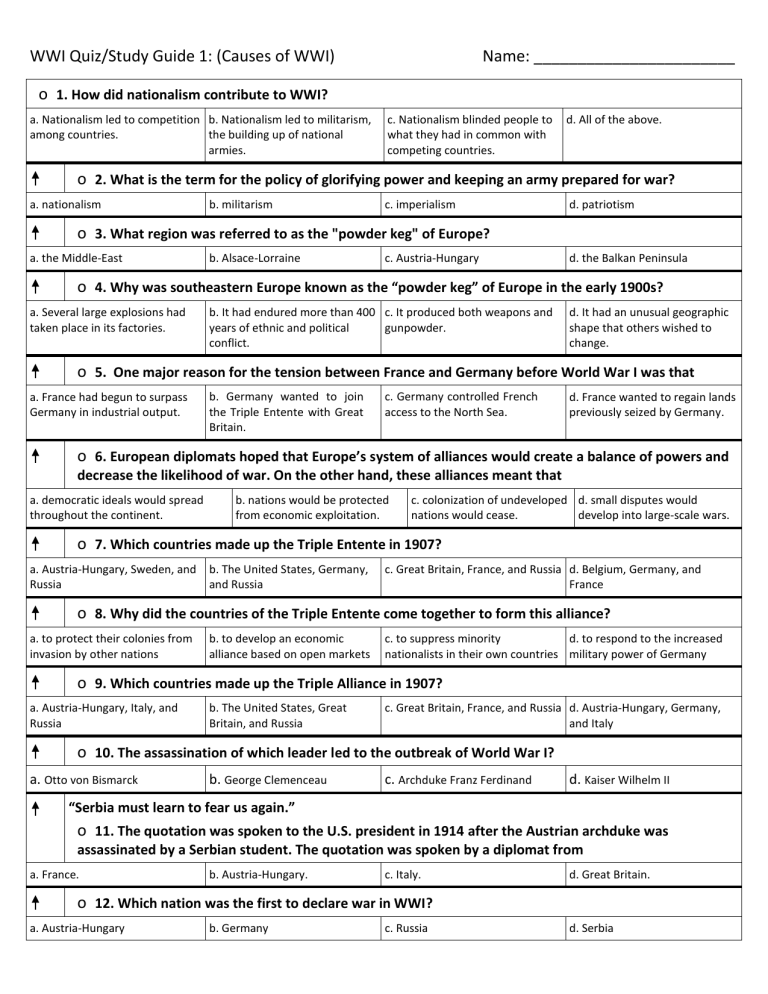
WWI Quiz/Study Guide 1: (Causes of WWI) Name: _______________________ o 1. How did nationalism contribute to WWI? a. Nationalism led to competition b. Nationalism led to militarism, among countries. the building up of national armies. c. Nationalism blinded people to what they had in common with competing countries. d. All of the above. o 2. What is the term for the policy of glorifying power and keeping an army prepared for war? a. nationalism b. militarism c. imperialism d. patriotism o 3. What region was referred to as the "powder keg" of Europe? a. the Middle-East b. Alsace-Lorraine c. Austria-Hungary d. the Balkan Peninsula o 4. Why was southeastern Europe known as the “powder keg” of Europe in the early 1900s? a. Several large explosions had taken place in its factories. b. It had endured more than 400 c. It produced both weapons and years of ethnic and political gunpowder. conflict. d. It had an unusual geographic shape that others wished to change. o 5. One major reason for the tension between France and Germany before World War I was that a. France had begun to surpass Germany in industrial output. b. Germany wanted to join the Triple Entente with Great Britain. c. Germany controlled French access to the North Sea. d. France wanted to regain lands previously seized by Germany. o 6. European diplomats hoped that Europe’s system of alliances would create a balance of powers and decrease the likelihood of war. On the other hand, these alliances meant that a. democratic ideals would spread throughout the continent. b. nations would be protected from economic exploitation. c. colonization of undeveloped d. small disputes would nations would cease. develop into large-scale wars. o 7. Which countries made up the Triple Entente in 1907? a. Austria-Hungary, Sweden, and Russia b. The United States, Germany, and Russia c. Great Britain, France, and Russia d. Belgium, Germany, and France o 8. Why did the countries of the Triple Entente come together to form this alliance? a. to protect their colonies from invasion by other nations b. to develop an economic alliance based on open markets c. to suppress minority d. to respond to the increased nationalists in their own countries military power of Germany o 9. Which countries made up the Triple Alliance in 1907? a. Austria-Hungary, Italy, and Russia b. The United States, Great Britain, and Russia c. Great Britain, France, and Russia d. Austria-Hungary, Germany, and Italy o 10. The assassination of which leader led to the outbreak of World War I? a. Otto von Bismarck b. George Clemenceau c. Archduke Franz Ferdinand d. Kaiser Wilhelm II “Serbia must learn to fear us again.” o 11. The quotation was spoken to the U.S. president in 1914 after the Austrian archduke was assassinated by a Serbian student. The quotation was spoken by a diplomat from a. France. b. Austria-Hungary. c. Italy. d. Great Britain. o 12. Which nation was the first to declare war in WWI? a. Austria-Hungary b. Germany c. Russia d. Serbia o 13. What did Russia, a largely Slavic nation, do after Austria-Hungary declared war on the Slavic nation of Serbia? a. declare war on Germany b. pledge to remain neutral c. prepare to send troops to support Serbia d. try to negotiate a settlement o 14. Why did Germany have a geographic disadvantage at the start of World War I? a. It was a landlocked nation. b. It was bordered by enemies on two fronts. c. Its inland mountain ranges were d. Its major rivers blocked the nearly impassable. movement of troops. o 15. Germany’s Schlieffen Plan for military attack was to a. first attack Russia with lightening speed before facing France in the West. b. attack France in the West before Russia in the East had a chance to mobilize. c. try to get the United States to align itself with Germany. d. engage both France in the West and Russia in the East at the same time. o 16. Great Britain’s stated reason for declaring war on Germany in 1914 was the a. French attacks on German territories b. U.S. entry into the war. c. Serbian assassination of Archduke Franz Ferdinand. d. German invasion of Belgium. o 17. What is the mistake in the following timetable of events leading up to WWI? 1. The assassination of a prince leads to an ultimatum from Austria Hungary to Serbia. 2. Austria-Hungary declares war on Serbia. Russia mobilizes its army to defend Serbia. 3. Germany declares war on Russia and its ally France. 4. Britain, France’s ally, declares war on Germany. 5. Germany’s troops enter neutral Belgium on the way to invade France. a. Austria-Hungary issued the ultimatum before the assassination of the prince. b. Germany declared war on Russia before Russia mobilized its troops. c. Germany declared war on Russia before Austria-Hungary declared war on Serbia. d. Britain declared war on Germany after Germany’s troops entered neutral Belgium on the way to invade France. o 18. The acronym “MAIN” is a way of remembering what four root causes of WWI? a. Mobilization, Alliances, Imperialism, Nationalism b. Militarism, Alliances, Industrialism, c. Militarism, Aggression, Nationalism Imperialism, Nationalism d. Militarism, Alliances, Imperialism, Nationalism o 19. World War I was a "total war" in the sense that a. it brought great suffering to civilians. b. nations from all over the world were involved. c. new technologies played a large d. the nations involved devoted part in the war. all their resources to it. o 20. Why was World War I known as "the war to end all wars"? a. The suffering it caused made further war seemed unimaginable. b. It lasted for years longer than anyone had thought possible. c. European military forces were demolished by the war's end. d. It was followed by the formation of the League of Nations. WWI Quiz 2 Study Guide: (Events of WWI) Name: _______________________ o 1. At the start of World War I, which nation was bordered by enemies on two fronts? a. France b. Germany c. Russia d. Great Britain o 2. What was significant about the Allied victory at the First Battle of the Marne? a. It prompted Great Britain to enter the war. b. It allowed Russia time to mobilize its army. c. It forced a stalemate and resulted in Germany's having to fight on two fronts. d. It stopped Germany from invading France. o 3. After the Battle of the Marne in 1914, German forces realized that victory a. would be theirs, as long as they stuck to the plan. b. on the Western Front would not be quick. c. against the West could only be won through trench warfare. d. in the East could only be achieved before the harsh Russian winter began. o 4. Trench warfare in World War I was characterized by a. a series of Russian victories. b. swift invasions and decisive attacks. c. heavy casualties and little territorial gain. d. tremendous German victories in the East. o 5. In November 2003, workers digging to build a highway near Ypres, Belgium, uncovered a network of shallow passages and found skeletons in World War I–era uniforms, newspapers, dishes and other items. The finding is most likely a. an unmarked World War I grave along the Eastern Front. b. a World War I hiding place for c. a bunk site for World War I civilians. troops. d. a site of trench warfare. o 6. In World War I, why did battles on the Western Front result in little territorial gain? a. German troops focused their efforts on the Eastern Front. b. Trench warfare made the movement of troops difficult. c. Troops on the Western Front were able to mobilize quickly. d. Western rivers and mountains provided natural barriers. o 7. Why did most of the combat on the Western Front in World War I take place in a relatively small area? a. There is only a small amount of flat land in all of Europe. b. The armies became immobile because of trench warfare. c. Each side cut off the fuel supply d. Germany’s military tactics of the other. were based on “static warfare.” o 8. What did the Central Powers gain over Russia at the battle near Tannenberg? a. Germany drove the Russians into full retreat. b. German forces killed the czar. c. Germany seized Russia's only port. d. All of the above o 9. During World War I, Russia’s main strength was its a. control of the seas. b. industrial production. c. large number of soldiers. d. military technology. o 10. Which of the following was a goal of the Allies' Gallipoli campaign? a. to gain access to Africa b. to capture Sarajevo c. to destroy Germany's U-boat fleet d. to establish a supply line to Russia o 11. How did Russia’s participation in World War I affect its empire? a. A string of decisive military victories gained land from the Central Powers. b. Russia’s sale of supplies to its western allies strengthened its economy. c. The czar adopted the reforms necessary to win the support of the Russian people. d. Economic hardships brought on by the war resulted in the downfall of the czar. o 12. What was the immediate goal of Lenin and the Bolsheviks after they took power in Russia in 1917? a. to gain access to Germany’s industrial resources b. to help the temporary government fight the war c. to end Russia’s involvement in the war d. to return the tsar to power o 13. What happened when the Treaty of Brest-Litovsk was signed? a. The Russians gave up land to b. The treaty ended World War I c. Germany withdrew from the Germany and pulled out of WWI. war. d. The United States entered the war. o 14. What impact did the Treaty of Brest-Litovsk have on Germany? a. It gave Germany the Russian army's aid against the Allies. b. It allowed Germany to focus all their efforts on the Western Front. c. Germany gained lands that were formerly part of Russia. d. Both b and c. o 15. One contribution of overseas colonies to the Allied effort during World War I was that they provided a. large numbers of soldiers to reinforce the Allied armies. b. protected sites for new Allied industrial factories. c. most of the agricultural labor in d. places of refuge for displaced the Allied nations. Allied civilian populations. o 16. Which country recruited colonial troops from India in World War I? a. Britain b. France c. Germany d. Japan o 17. After World War I, many colonies that had participated in the war made demands for independence primarily because a. American troops taught colonists that all men are created equal. b. colonists felt entitled to citizenship because they had served in the military. c. colonists were inspired by the example of the Russian Revolution. d. colonists were afraid for their jobs in the unstable European economy. o 18. Stories of German atrocities in Belgium were used as propaganda, meaning that the stories were used to a. encourage Belgium to support the war. b. make the Germans look worse c. convince neutral nations to fight d. show that the Germans than they were. for the German army. treated civilians humanely. o 19. Propaganda during World War I was used primarily to a. convince neutral nations to join the war. b. encourage a negotiated peace between the Allies and the Central Powers. c. raise support for the war effort on the home front by demonizing the enemy. d. reduce atrocities by clearly portraying the horrors of trench warfare. o 20. Which statement best describes the existence of atrocities during World War I? a. Both sides followed the rules of warfare and avoided civilian deaths. b. Germany was the only member of the Central Powers that killed civilians. c. The Allies were fighting for democracy and did not harm civilians. d. Both sides committed atrocities in pursuit of their military goals. c. the Turks. d. a European coalition. o 21. The Ottoman Empire was ruled by a. the Armenians. b. the Germans. o 22. The Armenians in Turkey were a minority group partly because they were a. atheist. b. Christian. c. Jewish. d. Muslim. o 23. What was the political position of the Armenians at the beginning of World War I? a. They supported the Turks. b. They supported the Allies. c. They wished to remain neutral. d. Their position was unknown. c. German nationalists d. the Turkish government o 24. Who committed the Armenian genocide? a. Allied troops b. foreigners in the Ottoman Empire o 25. How did the international community respond to Turkey’s actions against the Armenians? a. It supported the Turkish government’s actions. b. It tried to keep Turkey’s actions secret until after the war. c. It took no action to protect the Armenians. d. No one knew about the genocide until the war was over. o 26. In 1917, Germany returned to its policy of unrestricted submarine warfare, hoping to a. bring the United States into the war. b. force Russia to withdraw from c. keep cargo ships from reaching the war. Great Britain. d. destroy the British ships blockading German ports. o 27. Which German action was most important in bringing the United States into World War I? a. German invasion of Russia b. unrestricted submarine warfare c. keep cargo ships from reaching Great Britain. d. destroy the British ships blockading German ports. o 28. By the time the United States entered World War I, fighting was focused on a. the Eastern Front b. the Western Front c. former Russian territory d. the seas around Great Britain o 29. After entering World War I, the United States most helped the Allies by a. fighting Germany in the sea around Britain. b. negotiating with the Central Powers. c. sending the Allies supplies, troops, and monetary loans. d. trying to convince the Russians to return to fighting. o 30. Which of the following most affected the course and outcome of World War I? a. Allied withdrawal from the Turkish peninsula of Gallipoli b. British victories in the Sinai that secured the Suez Canal c. American military and financial intervention in the war d. the switch in allegiance of Italy from the Central Powers to the Allies o 31. What main motivation finally forced the Central Powers to surrender on November 11, 1918? a. They did not have the resources or soldiers to fight the Americans. b. The Germany army had been pushed back so far that defeat was inevitable. c. Austria-Hungary had already signed a peace treaty with the Allies. d. They no longer wanted to fight the large Russian army in the East. WWI Quiz/Study Guide 3: (Effects of WWI) Use the chart to answer questions 1-2. o 1. What conclusion can be drawn from these data about casualties in World War I? a. The Central Powers had more total casualties than the Allies. b. Most of the casualties were prisoners or missing. c. The Allies had a lower casualty rate than the Central Powers. d. The number killed was greater than the number wounded. o 2. Which reason for Allied victory is supported by the chart? a. fewer wounded soldiers b. greater number of troops c. deadliest weapons d. took more prisoners o 3. What is one reason why millions of European and Russian civilians died during World War I? a. They were not as strong as civilians during other wars. b. They did not hide from the c. The Allied troops ignored their plight d. Much of the fighting took enemy. place in Europe and Russia. o 4. Civilian casualties in World War I were a. fewer than military casualties. b. extremely rare. c. increased by disease and starvation. d. primarily due to overwork. o 5. U.S. president Woodrow Wilson’s Fourteen Points were a. the basis for determining German b. a charter for the League of reparations. Nations. c. an outcome of the Treaty of Versailles. d. a plan for postwar peace. o 6. Which statement best summarizes the idea of national self-determination as it was presented in Woodrow Wilson’s Fourteen Points? a. Strong national boundaries b. Voter participation in a democracy is c. All people have the right to strengthen national unity. the best way to encourage peace. independence from colonial rule. d. People should be able to decide on their type of government. o 7. The Big Four who negotiated the Treaty of Versailles represented France, Great Britain, the United States, and what other nation? a. Germany b. Italy c. Russia d. Spain o 8. Which of the following did the Treaty of Versailles require of Germany? a. payment of damages to its overseas colonies b. a public apology to the Allies c. acceptance of sole responsibility for the war d. division into two states: West Germany and East Germany o 9. A major goal of France and Britain at the Conference of Versailles following World War I was to a. create a politically unified b. keep Germany from Europe. rebuilding its military forces. c. restore pre-war imperial governments to power. d. help Germany rebuild its industrial economy. o 10. How did the Treaty of Versailles affect postwar Germany? a. It left a legacy of bitterness and hatred in the hearts of the German people. b. It stabilized the German economy and gave monetary aid to the nation. c. It left Germany in much the same state as it was before the war. d. It gave Germans the drive to rebuild their nation on a stronger foundation. o 11. The main purpose of the League of Nations was to a. keep the peace and prevent future wars. b. regulate commercial and economic competition. c. impose sanctions on aggressive nations. d. achieve international cooperation in governing colonies. o 12. What is the main reason that Americans rejected the League of Nations? a. They objected to Germany’s membership. b. They believed the financial aid it provided c. They feared it could lead to would burden the U.S. economy. future U.S. involvement in European wars. d. They did not want to help rebuild postwar Europe. o 13. Which statement best describes national economies in Europe after World War I? a. In most areas, wartime industry brought significant economic gains. b. Western Europe remained economically strong, but the economies of eastern and southern Europe were devastated. c. Almost all the major d. Although the war battered most economies were European economies, with the help of bankrupt. wartime reparations paid by Germany, they soon rebounded. o 14. In the 1920s, which nation was most burdened by war debt? a. Germany b. Great Britain c. Russia d. the United States o 15. By the end of World War I, what political tradition had essentially ended in Europe? a. rule by the old empires b. totalitarian government c. the democratic tradition d. competition among political parties o 16. Which generalization is true of political life in postwar Europe? a. People clung to old forms of government. b. Strong leadership made the public anxious. c. Many countries had no organized political parties. d. Changing forms of government created a sense of insecurity. o 17. One result of WWI was the rise of totalitarianism. The term totalitarianism describes a government that a. holds regular elections to choose its leaders at both the local and national level. b. takes centralized state control over every aspect of public and private life. c. trusts the masses to collectively decide on policy issues by way of popular vote. d. diligently advances personal freedoms and liberties for all of its people. Use the quotation to answer questions 18-19. “It is the State which educates its citizens in civic virtue, gives them a consciousness of their mission, and welds them into unity.” —Benito Mussolini, from The Social and Political Doctrines of Contemporary Europe, o 18. In the quotation, what post-World War I problem is Italian dictator Benito Mussolini most likely addressing? a. economic change b. a sense of loss c. weak political systems d. unemployment o 19. In the quotation, what is most central to Mussolini’s solution to political turmoil? a. state-run education b. individual opinions c. shared wealth d. a leader’s moral choices o 20. What actions led to the formation of new nations out of the Central Powers? a. Wilson's idea of selfdetermination that inspired revolutions in Europe b. military occupation of the defeated nations and redistribution of peoples c. provisions of peace treaties signed d. a direction by the with the Central Powers League of Nations to realign territories after the war o 21. The collapse of the Russian and Austro-Hungarian empires during WW I contributed directly to the a. formation of the European Union. b. start of the Cold War. c. development of the Marshall Plan. d. creation of new nations in Eastern Europe. Use the maps to answer questions 22-27. o 22. Who lost the greatest percentage of land in the creation of new nations? a. Austria-Hungary b. France c. Germany d. Russia o 23. Which nation was formed from the former lands of the Ottoman Empire? a. Albania b. Finland c. Hungary d. Turkey o 24. Which formerly dissolved nation was reconstituted on the Eastern Front? a. Bulgaria b. Czechoslovakia c. Poland d. Romania o 25. In what region of Europe were the new nations of Finland, Estonia, Latvia, and Lithuania created? a. northeast b. northwest c. southeast d. southwest o 26. After World War I, Serbia became part of a. Hungary. b. Romania. c. Russia. d. Yugoslavia. o 27. After national boundaries were redrawn, which of the Central Powers lost access to the sea? a. Austria-Hungary b. Germany c. The Ottoman Empire d. Russia o 28. After World War I, many artists, architects, writers, and musicians rejected a. government funding. b. traditional styles. c. cultural change. d. their own feelings. o 29. The literature of "lost generation" writers was characterized by a. disillusionment. b. melodrama. c. patriotism. d. surrealism. o 30. The “lost generation” of writers who gathered in Paris were considered “lost” because a. the war had left them with a sense of meaninglessness. b. they wrote about soldiers who were unable to return home. c. their homes were destroyed in the war. d. shifting boundaries meant they no longer lived in their nations of origin. o 31. Authors Ernest Hemingway and F. Scott Fitzgerald are identified with a. the lost generation. b. romanticism. c. the classical era. d. naturalism. Use the quotation to answer the questions 32-33. In the post-World War I novel, All Quiet on the Western Front, a young soldier named Paul says of the older generation: “The idea of authority, which they represented, was associated in our minds with a greater insight and a more humane wisdom. But the first death we saw shattered this belief.” —from All Quiet on the Western Front, Erich Maria Remarque o 32. What common post-World War I literary theme is characterized by Paul in the quotation from All Quiet on the Western Front? a. Poor military leadership had created a war that could not be won. b. Young soldiers were lured to die c. The horrors of war destroyed the in battle under false pretenses. young soldiers’ trust in their elders. d. Life on the battlefield meant that soldiers rarely saw their leaders. o 33. Which emotion best describes both Paul’s words in the quotation? a. patriotism b. terror c. relief d. disillusionment o 34. Which project would most likely have been undertaken by a post–World War I European artist such as Pablo Picasso or René Magritte? a. mural for a new government building b. drawing of an image from a dream c. portrait of the royal family d. painting of a romantic landscape o 35. What project would likely be chosen by a European architect, such as Le Corbusier or Gropius, after World War I? a. a luxury apartment building b. a splendid monument honoring c. a space-efficient dormitory decorated with carved limestone the new state leadership built of steel and glass d. the restoration of a palace that was damaged in the war
